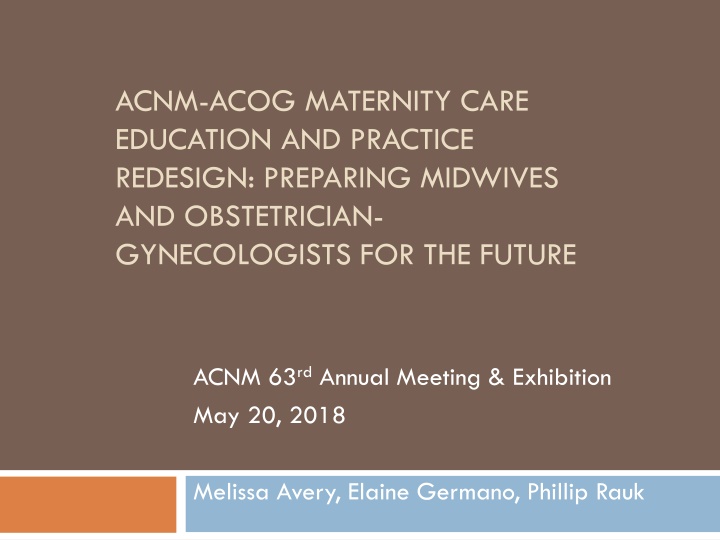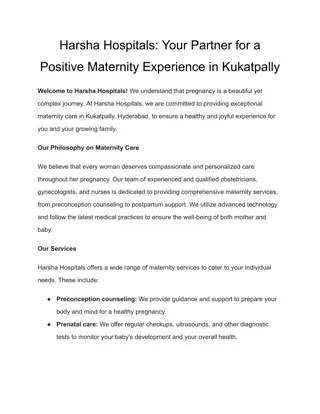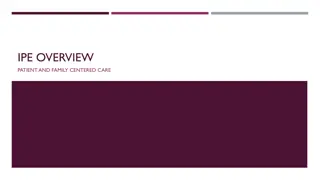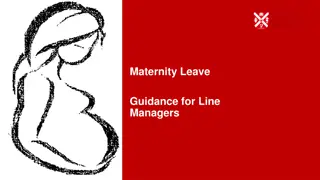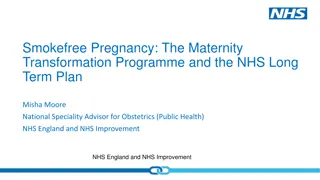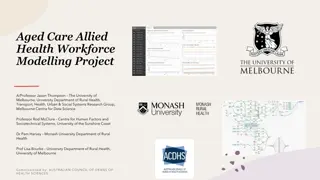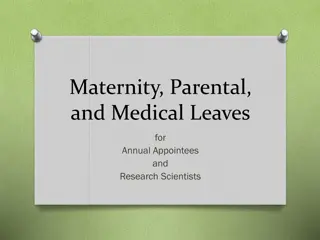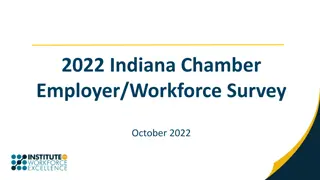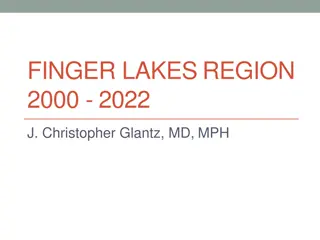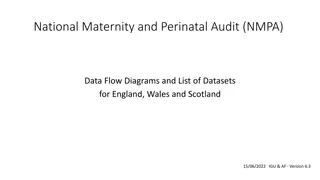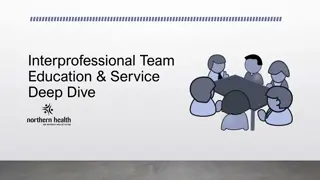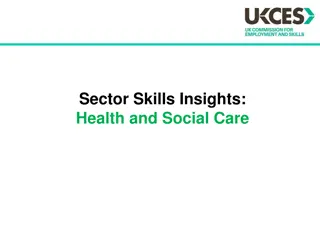Addressing Maternity Care Workforce Shortages: A Focus on Interprofessional Education
Explore the challenges and solutions regarding the projected maternity care workforce shortage in the US. Delve into the importance of interprofessional education for midwifery students and OB-GYN residents, as highlighted in the ACNM-ACOG initiatives. Discover the critical need for change in maternity care practices to improve outcomes for mothers and newborns, reduce disparities, and optimize the distribution of care providers.
Download Presentation

Please find below an Image/Link to download the presentation.
The content on the website is provided AS IS for your information and personal use only. It may not be sold, licensed, or shared on other websites without obtaining consent from the author.If you encounter any issues during the download, it is possible that the publisher has removed the file from their server.
You are allowed to download the files provided on this website for personal or commercial use, subject to the condition that they are used lawfully. All files are the property of their respective owners.
The content on the website is provided AS IS for your information and personal use only. It may not be sold, licensed, or shared on other websites without obtaining consent from the author.
E N D
Presentation Transcript
ACNM-ACOG MATERNITY CARE EDUCATION AND PRACTICE REDESIGN: PREPARING MIDWIVES AND OBSTETRICIAN- GYNECOLOGISTS FOR THE FUTURE ACNM 63rdAnnual Meeting & Exhibition May 20, 2018 Melissa Avery, Elaine Germano, Phillip Rauk
Session Objectives Identify projected maternity care workforce shortage Describe interprofessional education (IPE) core competencies from several key documents Describe IPE curriculum and innovations at 4 project demonstration sites Identify barriers and solutions to implementing IPE for midwifery students and ob-gyn residents
ACNM-ACOG Interprofessional Education Workgroup Discussions 2014, meeting June 2015, ACNM Josiah Macy Jr. Foundation: 2/15/2017 2020 Co-PIs Melissa Avery and John Jennings 4 demonstration sites, CNM-MD Co-leads University of California, San Francisco Baystate Medical Center University of Minnesota Partnership site Frontier Nursing University, Drexel University, Reading Hospital Tower Health
Reasons for project Maternity care workforce shortage, maldistribution 40% of US counties, no maternity care provider Number ob-gyn physicians and midwives per population not increasing Need for change in maternity care practices Sub-optimal outcomes US mothers and newborns Cost of maternity care Shortage of providers Health disparities
CNMs and OB/GYNs per 100,000 Population Data Current as of 2011 CNMs & OB/GYNs per 100,000 0 0.1 29.9 30.0 + Out of 3,142 U.S. Counties, 1,263 (40%) have no CNM or OB. Sources in Notes View.
Maternity Care Providers per 10,000 Women Age 15+ Years 10.00 Providers per 10,000 Women 9.00 The ratio has not changed appreciably in 16 years. 8.00 7.00 6.00 5.00 4.00 3.00 2.00 1.00 0.00 2010 2000 2001 2002 2003 2004 2005 2006 2007 2008 2009 2011 2012 2013 2014 2015 OB/GYNs CNMs/CMs Total Sources in Notes View.
Maternal Care Workforce in Developed Countries: Midwives per Obstetrician
Purposes of project Redesign maternity care to a team-based model of care through interprofessional education of midwives and ob-gyns Increase the number of annual midwifery graduates
Why team-based care? Maximizes human and financial resources Shared responsibility Patient becomes center of care Efficiency and quality improved
Defining team-based care Team-based care: Provision of health services to individuals, families, communities by at least two providers who work with patients and families to accomplish shared goals within, across settings to achieve coordinated, high-quality care Collaboration: A process involving mutually beneficial active participation between autonomous individuals whose relationships are governed by negotiated shared norms and visions
And Team -based care and collaboration are not presented/supported as policy recommendations to limit or restrict provider scope of practice. Rather, the team focus is on meeting the needs of the patient while maximizing the expertise of all health care providers on the team.
Conceptual framework Four dimensions, each with related concepts Organizational Shared vision, shared interest, commitment Procedural Shared decision making, coordination, role clarity Relational Communication, trust, respect, reciprocity Contextual Shared power Smith DC, 2014 JMWH
Key Documents Core Competencies for Interprofessional Collaborative Practice: 2016 Update Expert panel, 2011, Interprofessional Education Collaborative (IPEC) American Association of Colleges of Nursing American Association of Colleges of Pharmacy American Association of Osteopathic Medicine American Dental Education Association Association of American Medical Colleges Association of Schools and Programs of Public Health
Key Documents (cont.) IPEC Goal: to help prepare future health professionals for enhanced team-based care of patients and improved population health outcomes Four core competencies organized under domain of Interprofessional Collaboration: Values/Ethics for Interprofessional Practice Roles/Responsibilities Interprofessional Communication Teams and Teamwork
Interprofessional Collaboration Competency Domain
Key Documents (cont.) Collaboration in Practice: Implementing Team-Based Care, ACOG, multi-disciplinary Task Force on Collaborative Practice, 2016. https://www.acog.org/Clinical-Guidance-and- Publications/Task-Force-and-Work-Group- Reports/Collaboration-in-Practice-Implementing-Team- Based-Care Team Strategies & Tools to Enhance Performance and Patient Safety (TeamSTEPPS), a teamwork system health care professionals by Agency for Healthcare Research and Quality (AHRQ) https://www.ahrq.gov/teamstepps/index.html
Collaboration in Practice Task force report completed and released March 2016 Exec summary published Obstetrics & Gynecology Full report on ACOG s website - open access Additional resources links to report, exec summary www.acog.org/More- Info/CollaborativePractice
Collaboration in Practice: Implementing Team-Based Care Patient and families are central to and engaged as members of the health care team Team has a shared vision Role clarity is essential to optimal team building and functioning All team members are accountable to their own practice and to the team Effective communication is key Team leadership is situational and dynamic
TeamSTEPPS Evidence-based teamwork tools, to optimize patient outcomes by improving communication and teamwork skills among health care professionals Several versions, plus individual modules for specific audiences, settings, or situations Online version available
TeamSTEPPS Curriculum Three Courses: Essentials: key principles and concepts Fundamentals: Introduction, Team Structure, Communication, Leading Teams, Situation Monitoring, Mutual Support, Summary Supplemental: Change Management, Coaching Workshop, Measurement, Implementation Workshop, Practice Teaching Session https://www.ahrq.gov/teamstepps/instructor/index.html
TeamSTEPPS Key Principles Team Structure Communication Leadership Situation Monitoring Mutual Support Get the app! https://www.ahrq.gov/teamstepps/instructor/essentials/pocketguidea pp.html
Objectives for the ACNM-ACOG funded IPE project Develop/implement IPE curriculum for midwifery students & ob-gyn residents Find solutions to site-specific barriers to fully implementing IPE curricula Align accreditation criteria and core IPE competencies/objectives for ob-gyn residents and graduate midwifery students Increase the number of midwifery graduates
4 Demonstration Sites CNM and MD lead Baystate Medical Center: Sukey Krause, CNM and Heather Sankey, MD Frontier Nursing University Partnership Site: Tonya Nicholson, CNM Tower Health/Reading Health Systems: Audrey Perry, CNM and Mark Woodland, MD Drexel University: Owen Montgomery, MD University of CA, SF: Kim Dau, CNM, Meg Autry, MD University of MN: Melissa Avery, CNM, Phillip Rauk, MD
Work to date Planning meeting June 2017, Minneapolis ACOG Team-based care document as framework Modules under development Simulation activities ongoing, in development Evaluation plan developed Accreditation related group has met Implementation phase begins summer 2018 Will be involving consumers
4 IPE programs developing How are modules used throughout programs? What lab and simulation activities? How to put learners together in clinical settings? How does each site overcome barriers? Can we increase number of midwifery grads? Does it make a difference in our learners? Can we connect with them post-program? Implementation years 2 and 3
Module development Introduction to Guiding Principles Patient Centered Care CNM/CM and Ob-gyn role clarification Collaborative Practice (to include levels of care) History, culture of both professions, birth as illness vs normal, role of women Care transition, situational leadership Difficult conversations (between providers and with patients)
Module structure and content Topic and Brief Introduction Objectives Content Outline Lecture Materials Slides Resources/Readings Optional Video with Transcript Learning Activities Timeframe description
Learning activities Quiz questions, pre and post In-class discussion questions Videos with discussion RolePlay/Simulations: Scenario description Identification of roles/players involved Debriefing questions
Description of activities by site Baystate Medical Center Frontier University Partnership Frontier midwifery students Ob-gyn residents at Reading Hospital/Tower Health Ob-gyn residents at Drexel University Medical Center University of California-San Francisco University of Minnesota
Baystate Medical Center History and Culture of Two Professions Module history birth as normal physiologic event vs pathological medical event Communication simulation, transfer of care among midwifery students, first and third year residents Series of IPE clinical topic days in 2018, including domestic violence and the neurobiology of assault
Frontier Partnership Site Care Transition/Situational Leadership Module Frontier University midwifery students to Drexel for simulation exercises with ob-gyn residents Reading Hospital/Tower Health for IPE in birth center and transition to in-hospital setting All Reading Hospital providers, select nurses, and students have participated in TeamSTEPPS modules Drexel team helping in development, will share materials IPE professionalism
University of California-San Francisco Patient Centered Care and Collaborative Practice Modules TeamSTEPPS training for residents and midwifery students Poverty simulation with residents, midwifery students, nursing students, and community members, addressing health disparities Discussion with midwifery students and residents; roles, responsibilities and scope of practice
University of Minnesota Role Clarification module, 5 demonstration videos Skills lab for 1st year ob-gyn residents and 2nd year midwifery students OSCE with three IPE cases for 3rd year midwifery students and 2nd year ob-gyn residents Residents, midwifery students do TeamSTEPPS Planning journal club, joint suturing labs, IPE days https://drive.google.com/drive/folders/0B8rmu3tsw2mxeFYtVWUwY2hqelU
Overcoming barriers and challenges Scheduling Different types of programs Professional cultural differences Differences in program funding Multiple sites with principle investigators and project manager all in different locations
Evaluation Summary of all activities Number of learners reached by activities Site specific information Satisfaction, input on specific activities Consumer feedback on clinical activities Tools for pre-post evaluation
Project Evaluation Tools IPEC Competency Self-Assessment Tool 16 item tool Questions re ability to communicate with other health professionals, provide team-based care, maintain own competence, respect for patients, leadership Interprofessional Collaborative Competencies Attainment Survey (pre-post) 20 items Communication, collaboration, roles, pt. centered, conflict management, team functioning
Ongoing planning Web site to host modules, learning activities, other resources & information, launch in June Further analysis of residency program survey Planning to place residents and midwifery students together in clinical settings Interface with others who are recognizing importance of IPE
Advancing high value maternity care through physiologic childbearing National Partnership for Women and Families Blueprint Six Strategies Innovative delivery and payment systems, QI Advance performance measures Engage childbearing women and families Interprofessional education for maternity care professionals Optimal maternity care workforce and distribution Research to advance science of physiologic childbearing http://www.nationalpartnership.org/issues/health/maternity/ 39 National Partnership, May 2018.
Preliminary survey data 35 responses, 5 duplicates Median # residents is 6 25 of 30 programs, midwives teaching residents 8 of 29, physicians teach midwifery students 9 of 30 responding have a midwifery program 1- 11 or more midwifery students Midwifery students and residents learn together in 14 of 30 7 of 30 able to take additional midwifery students
Dissemination APGO-CREOG meeting in March 2018 ACNM meeting Will submit to ACGME meeting Ongoing as opportunities arise White paper on accreditation planned
